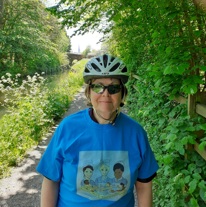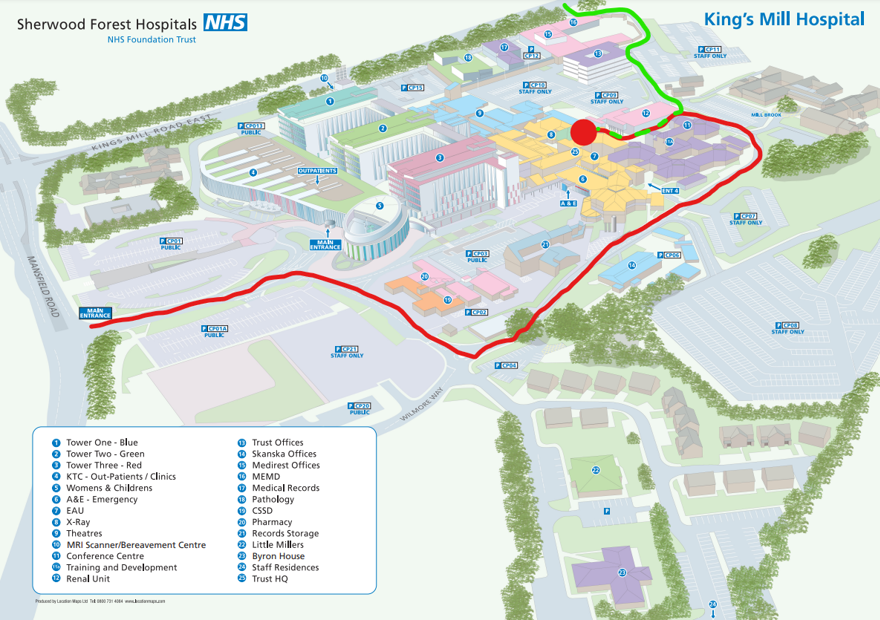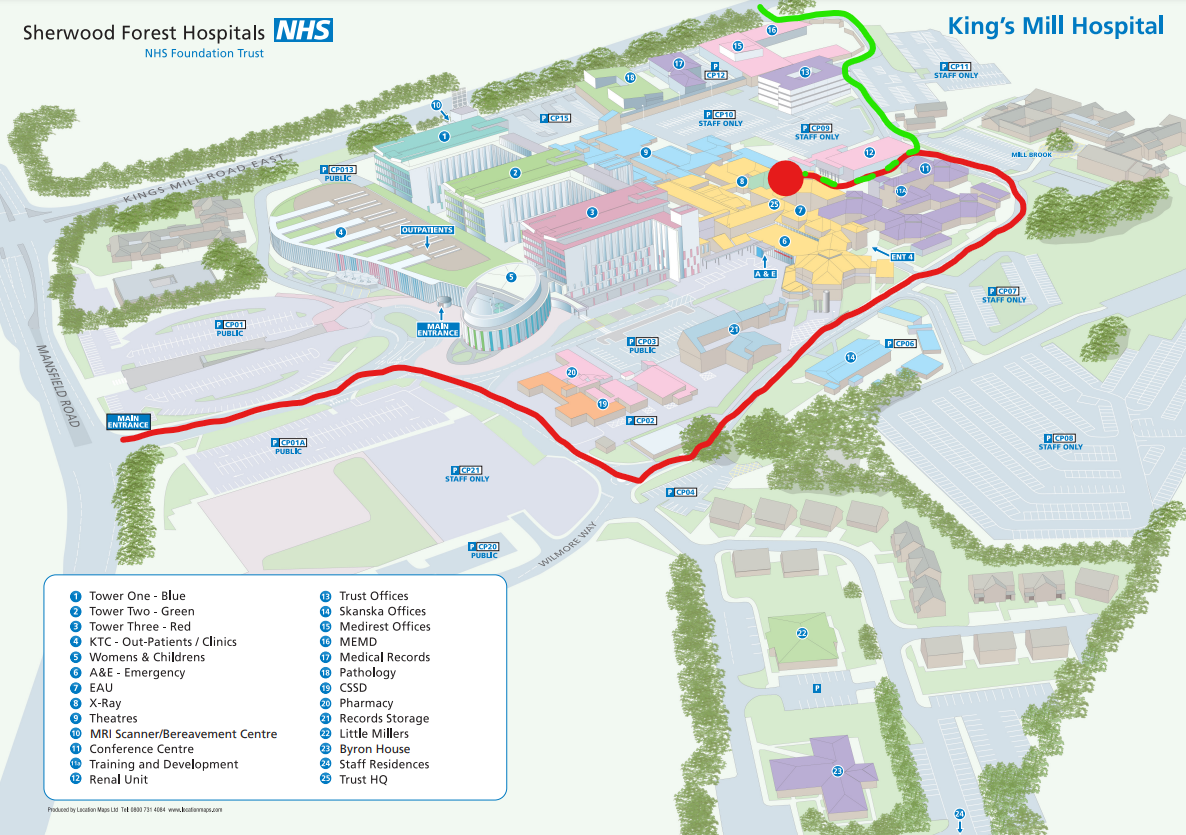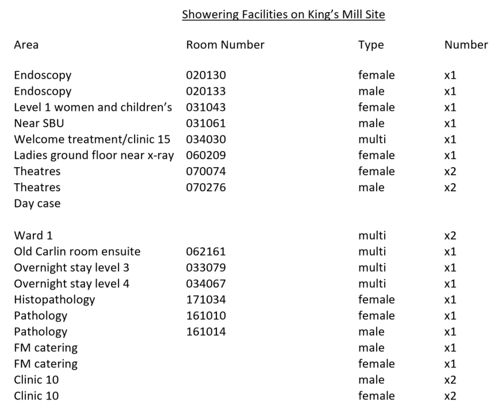Cycling to Work
Welcome to the 'Cycle to Work' webpage for Sherwood Forest Hospitals.
 I am Dr Richard Hastings, Consultant in General Paediatrics and Cycle to Work Lead.
I am Dr Richard Hastings, Consultant in General Paediatrics and Cycle to Work Lead.
If you're reading this it is likely that you already cycle to work, or are considering it? Either way, you'll find some useful information here.
The Cycle to Work scheme is only at the King's Mill Hospital site at the moment, but we hope to have more information about other sites at Sherwood soon.
If you want to discuss any of the information here or if you'd like to help support your colleagues to cycle to work, contact your C2W champions:
- Claire Allison (claire.allison2@nhs.net)
- Tom Adams (tom.adams2@nhs.net)
- Richard Hastings (rhastings@nhs.net)
We are hoping to recruit local cycle to work champions within the Trust to support and advise SFH colleagues to cycle to work? If you would like to be a C2W Champion please contact one of the Champions listed above.
This is a government initiative that encourages more people to cycle to work by offering tax exemptions on buying a bike. The savings you make could be up to 40% of the value of the bike, but this does depend on a number of factors including the price of the bike you are buying and your salary. In simple terms, the cost of your bike is spread over 12 months or more and the monthly cost is taken from your gross salary before tax and National Insurance contributions are removed. You are actually leasing the bike and there is usually a small payment at the end to gain ownership.
Don't forget that you can include other products that are essential to your cycle commute such as a lock, lights, cycle clothing and a helmet.
For more information, see the Vivup website.
Richard - Cycle to Work Champion
I've almost always commuted to work by bike. I've rotated to different hospitals around the region and sometimes I've been able to cycle the whole journey, sometimes I've combined cycling with a train journey and at KMH I usually combine cycling with a car journey (I drive halfway, park, and then take my bike out of the back of my car). I find cycling to work has a very positive effect on my mood for the rest of the day. Commuting by bike maintains my fitness level without needing a gym membership (or finding time to go to the gym). Another motivator for me is that I feel that my children are more likely to be active because they see me exercising every day.
Claire - Cycle to Work Champion I’m Claire, I am one of the Trust cycling to work champions, but I don’t fit your imagined cyclist profile. Cycling has been part of my whole life, with lots of different phases and currently, I cycle for pleasure and to keep active. We cycle the hundreds of canal towpath miles the UK has to offer with our panniers full, for a week away free from the constraints of possessions and a vehicle. There is instant peace, tranquillity and lots of wildlife, plus there are watering holes for people along the way!
I’m Claire, I am one of the Trust cycling to work champions, but I don’t fit your imagined cyclist profile. Cycling has been part of my whole life, with lots of different phases and currently, I cycle for pleasure and to keep active. We cycle the hundreds of canal towpath miles the UK has to offer with our panniers full, for a week away free from the constraints of possessions and a vehicle. There is instant peace, tranquillity and lots of wildlife, plus there are watering holes for people along the way!
Cycling to work for me started eight years ago, I purchased my first cycle to work bike complete with a pannier rack and I haven’t looked back. I was working clinically and managing a busy department at the time and the ride to and from work gave me space to think and reflect on the day. I don’t cycle every day, I need to be in the mood and the weather right! Each ride to and from work has an event that wouldn’t have happened in the car. I was once aware that a buzzard was circling above me whilst cycling along the MARR Rd and I really hoped it wasn’t eyeing me up for dinner, what a sight and experience! I have since changed my role and now mostly work from home, so when I do travel into the KMH site I cycle in complete with my laptop, the extra weight helps to improve my fitness!
The route I travel is mainly on maintained cycle paths and I have been known to trim back the hedges with secateurs to keep the paths clear for all of us.
My top tips for cycling to work is to have the appropriate clothing for the weather and have a wash kit at work. Helmet hair can be a put off, but no one has ever said “Claire you look scruffy today!”
Give it a try, even if it's once a week. You will definitely feel like you have won the day.
Enjoy the fresh air.
Tom Adams - Cycle to Work Champion
Why do I cycle to work? I cycle to work for fitness, economic, time saving and environment reasons.
Most of the time I like to cycle as fast as I can for the cardio benefits. Everyone has their own style of riding. Cycling is also very cheap. I don’t pay to park, my fuel is Shreddies and I can fix the common mechanical issues myself. I’ve even sold my car and go shopping with my bike and as a family, we plan many days out just using bikes – the kids love it! Riding bikes does also save me time such as no idling in traffic jams etc. I am highly aware of the great environmental crisis we face and decided to take my own car off the road to aid this cause. We do still have a car for camping trips and big shops. We use the bus a lot also. The car hardly moves really. Being out on my bike at all times I see lots of wildlife I would not see pinging around in a metal box and this aids my mental wellbeing I suspect. I also have many conversations with people I would in no way speak to stuck in my car getting angry at the traffic jams I was part of.
Overall I’m quite a determined cyclist. I ride into work every day of the week in all weather except very high winds; this is my bus day! I do wear the dreaded cycling clothing as its comfortable for the distance I ride in daily. When I’m riding around town etc I just wear jeans and a jumper etc. You just wear whatever is comfortable. I carry pannier bags on my bike and carry in my work kit. I have previously commuted with a laptop for 2 years without problem. I’ve cycled all my life. I seem to cycle more year on year. I began commuting to work 5 years ago, the frequency improving each year to my now 5 day routine and I can honestly say my quality of life has never been better.
Start small, maybe 1 day per week and see how you get on. Give it a go!
Cycling is excellent exercise. It helps people meet recommended physical activity guidelines and improves their physical and mental health and their wellbeing while reducing the risk of premature death and ill-health.
Cycling fits into daily routines better than many other forms of exercise, because it doubles up as transport to work, school or the shops etc. It’s easier than finding extra time to visit the gym and far less costly.
Cycling to work is linked with a 45% lower risk of developing cancer, and a 46% lower risk of cardiovascular disease, compared to commuting by car or public transport.
In England, physical inactivity causes around 37,000 preventable premature deaths p.a. amongst people aged 40-79. In 2015, there were 525 thousand admissions in NHS hospitals where obesity was recorded as a factor.
Should I be worried about the risks of cycling?
Like anything in life, there are risks to cycling. The question is do the benefits of cycling outweigh the risks?
The health benefits of cycling outweigh the injury risks by between 13:1 and 415:1, according to studies. The figure that is most often quoted is 20:1 (life years gained due to the benefits of cycling v the life-years lost through injuries).
Resource: Cycling UK
Buying a bike can be a bit bewildering! Hybrid, road, gravel, mountain, electric...which is right for me...how much do I need to spend?
Some questions to consider when buying a bike...
- What is my budget?
- What will I use my bike for?
- Will I be sticking to roads or riding on more rough surfaces?
- Do I want a bit of extra help up those hills (an electric bike)?
- Does my commute also include some public transport (a folding bike might be useful)?
How much do I need to spend on a bike?
Prices can range from £100 to £10,000+ and it's difficult to suggest what the right amount of money is for you. This wide price range means that you should be able to find something to suit your budget. Generally, as with most things, the more you spend the higher the quality frame and components (gears, brakes etc) you will get. Don't forget you may be able to get a significant saving, and interest-free purchase by buying through a cycle to work, salary sacrifice scheme (through Vivup here at SFH).
How much do I need to spend on clothing and equipment?
There are only 3 things that are essential to buy, and they can all be purchased with significant savings if you buy them alongside a new bike through a salary sacrifice scheme (Vivup).
- Lights - £25+
- Lock - £25+
- Helmet - £25+
There is no need to spend money on specialist clothing when you start off, but as you become more enthusiastic about cycling you may chose to spend on cycling jackets and gloves. For me, the best value items to keep you warm when cycling in the Winter are a scarf/snood (£5+) and overshoes (a bit like an overcoat for your shoes, £20+).
What type of bike should I buy?
The answer to this question will depend on what you want/need to do on your bike. Here is an overview of the types of bikes and what they are used for...
- Mountain bike
Rugged tyres, sturdy frame. Many come with front suspension which makes riding over rough terrain more comfortable. Heavier than a more road-oriented bike so generally a bit slower and requires more effort when riding on roads. - Road bike
Drop handlebars, lighter frame and components, narrower wheels, no suspension. For many, a bit less comfortable to ride than a mountain or hybrid bike but the fastest bike on roads. - Hybrid bike
Somewhere between a mountain and road bike. Straight handlebars like a mountain bike but generally the frame looks more like a road bike. Some may have a front suspension. They have a more upright riding position that is generally more comfortable. - Gravel bike
Like a hybrid, they are somewhere between a mountain and road bike. Drop handlebars, a light but sturdy frame, coupled with tyres that a bit wider than you would find on a road bike. More expensive models may have some form of suspension. Often thought of as a 'do-it-all' bike. - Folding bike
The name says it all. A bike that can be folded to create a smaller package. Often used when your commute involves riding as well as travel on a bus or train. Can also be used to fold it down and easily put it in your boot if part of your commute involves a car journey. - Electric bike
An increasingly popular (and increasingly affordable) option. Electric power can be found in any of the bike types listed above. Benefits include the ability to travel further and generate less sweat on your way to work. More information can be found here.
E-bikes are a great option for many people. The number of e-bikes available on the market is expanding rapidly and prices are falling.
But why would you decide to buy an e-bike?
You don't want to be too sweaty when you arrive at work.
For me, my cycle commute to work is my aerobic workout for the day. Given that, I like to shower once I arrive at work. But that may not suit everyone and an e-bike is a great way to reduce the effort (and so sweating) during your commute. Why not use electric on the way to work and then turn the electric assist off or down for your ride home?
You have a long commute.
It may be that your level of fitness at the moment means that cycling to work is that bit too far for you. An e-bike can increase your range and over time as your fitness improves, you can reduce the electric assistance you use.
You want to travel faster to reduce your commute time.
Using an electric bike may well increase your travel speed and so reduce your commute time.
You ride with a friend who is faster than you are.
A great way for two friends of different speeds to ride together is for one of them to use an electric bike.
How much will an e-bike cost?
As for all bikes, there is a wide price range for e-bikes. You can expect to pay anything upwards of £500. The number of e-bikes on the market is rising very fast and alongside this, the prices of e-bikes are falling all the time. E-bikes come in a wide variety of frames including mountain, hybrid, road and folding bikes. There are also systems available that convert a standard bike into an e-bike.
The main cycling sheds at Kings Mill Hospital are near the Education centre, behind the renal unit. Follow the red route from the main entrance to the hospital or the green route from Kings Mill Road East.
What3words reference = dare.food.honey

There is a secure facility with bike racks and a door locking system that requires a 4-digit code. Once you have the code you can open the box which provides access to the padlock key.
The 4-digit code for access to the cycling sheds can be obtained by contacting Wes Burton.
Please be mindful of others when using the facility. Store locks that are not in use on the wire fencing around the facility rather than on the bike racks. If you are planning on leaving SFH permanently, then please take your lock when you leave the Trust.
Alternatively, there are further cycle racks, including a covered racking system just outside the main entrance to the hospital.
There are a number of showers available for staff spread across KMH.


Details on facilities at other SFH sites coming soon..
The following websites are all useful for finding cycle-friendly routes...
Below are some tips from Dr Hastings, one of our Cycle to Work Champions.
There is no escaping the fact that getting wet on a cycle ride can be unpleasant!
But as a wise person once said...
"There is no such thing as bad weather, only unsuitable clothing!"
With that in mind, here are some of the things to consider...
- Clothing
Consider using multiple layers of clothing. This could include a base layer, a mid-layer and an outside layer. Any of these could be removed depending on the weather conditions. - Keep an eye on the weather forecast for the temperature and likelihood of rain
When the temperature is below 10C I personally use a base layer, a cycling jersey and a light cycling jacket. If light rain is expected I carry a very thin water-resistant jacket in my bag. When heavier rain is expected I have a thicker, more water-resistant jacket with one or more layers underneath, dependent on the temperature. - Scarf/Snood
Not to be underestimated to keep you warm and cosy. Inexpensive. - Overshoes
These can be found in various thicknesses. Some are very thick and designed for the toughest winter conditions whereas others add an extra layer for just slightly toastier feet. - Mudguards
These can be bolted on the bike or clip-on. Even very good designs can be inexpensive. Highly recommended to reduce a wet bottom and wet feet. Also helps protect the bike. - Glasses
Consider using glasses to protect your eyes from flying insects. They can be tinted or clear.
